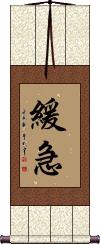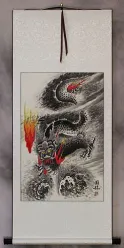Many custom options...
And formats...

Speed Control in Chinese / Japanese...
Buy a Speed Control calligraphy wall scroll here!
Speed Control
Wan Geub
緩急 is often used as a Korean martial arts term, “speed control.” It's also one of the 8 key concepts of Tang Soo Do.
In other contexts, this can mean priority, pace, tempo, or slow and fast.
This in-stock artwork might be what you are looking for, and ships right away...
Not the results for speed control that you were looking for?
Below are some entries from our dictionary that may match your speed control search...
| Characters If shown, 2nd row is Simp. Chinese |
Pronunciation Romanization |
Simple Dictionary Definition |
マスコン see styles |
masukon マスコン |
(abbreviation) (See マスターコントローラー) lever used to control the speed of a train |
Variations: |
yurumeru ゆるめる |
(transitive verb) (1) (ant: 締める・1) to loosen; to slacken; (transitive verb) (2) to relax (attention, efforts, etc.); to let down (one's guard); to relieve (tension); (transitive verb) (3) to relax (a rule); to ease (e.g. restrictions); to loosen (control); (transitive verb) (4) to reduce (speed); to slow down; to ease up; (transitive verb) (5) to make more gradual (of a slope) |
Variations: |
yurumeru ゆるめる |
(transitive verb) (1) (ant: 締める・1) to loosen; to slacken; (transitive verb) (2) to relax (attention, efforts, etc.); to let down (one's guard); to relieve (tension); (transitive verb) (3) to relax (a rule); to ease (e.g. restrictions); to loosen (control); (transitive verb) (4) to reduce (speed); to slow down; to ease up; (transitive verb) (5) to make more gradual (of a slope) |
Variations: |
masutaakontorooraa; masutaa kontorooraa / masutakontoroora; masuta kontoroora マスターコントローラー; マスター・コントローラー |
lever used to control the speed of a train (wasei: master controller) |
The following table may be helpful for those studying Chinese or Japanese...
| Title | Characters | Romaji (Romanized Japanese) | Various forms of Romanized Chinese | |
| Speed Control | 緩急 缓急 | kankyuu / kankyu | huǎn jí / huan3 ji2 / huan ji / huanji | huan chi / huanchi |
| In some entries above you will see that characters have different versions above and below a line. In these cases, the characters above the line are Traditional Chinese, while the ones below are Simplified Chinese. | ||||
Successful Chinese Character and Japanese Kanji calligraphy searches within the last few hours...





